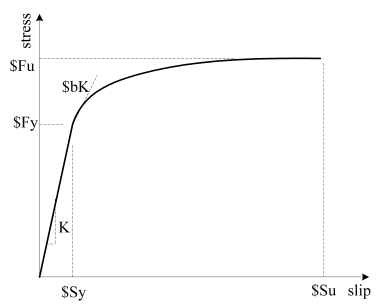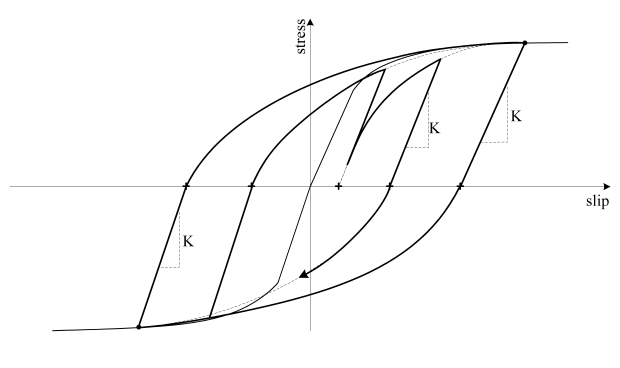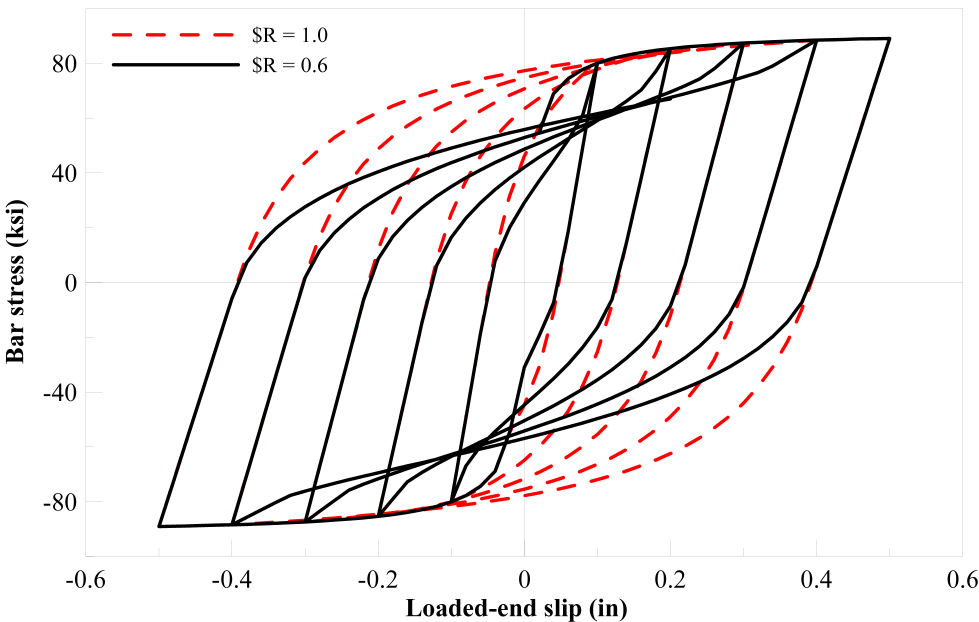Bond SP01 - - Strain Penetration Model for Fully Anchored Steel Reinforcing Bars: Difference between revisions
No edit summary |
No edit summary |
||
| Line 2: | Line 2: | ||
{| | {| | ||
| style="background:yellow; color:black; width:800px" | '''uniaxialMaterial Bond_SP01 $matTag $Fy $Sy $Fu $Su $b $R''' | | style="background:yellow; color:black; width:800px" | '''uniaxialMaterial Bond_SP01 $matTag $Fy $Sy $Fu $Su $b $R''' | ||
|} | |||
This model is for fully anchored steel reinforcement bars that experience bond slip along a portion of the anchorage length due to strain penetration effects, which are usually the case for column and wall longitudinal bars anchored into footings or bridge joints | This model is for fully anchored steel reinforcement bars that experience bond slip along a portion of the anchorage length due to strain penetration effects, which are usually the case for column and wall longitudinal bars anchored into footings or bridge joints | ||
| Line 23: | Line 23: | ||
| '''$R''' || Pinching factor for the cyclic slip vs. bar response (0.5~1.0) | | '''$R''' || Pinching factor for the cyclic slip vs. bar response (0.5~1.0) | ||
|} | |} | ||
Monotonic bar stress vs. slip response as modelled in Bond_SP01 | |||
[[Image:BondSPMonotonic.png]] | |||
Cyclic bar stress vs. slip response as modelled in Bond_SP01 | |||
[[Image:BondSPCyclic.png]] | |||
Pinching effect represented by $R in Bond_SP01 | |||
[[Image:BondSPPinching.png]] | |||
NOTES: | NOTES: | ||
'''$Sy''' Rebar slip at member interface under yield stress and may be obtained from | |||
[[Image:BondSP_Sy1.png]] | |||
or | |||
[[Image:BondSP_Sy2.bmp]] | |||
where: | |||
# '''db''' is rebar diameter | |||
# '''$Fy'''is yield strength of the reinforcement steel | |||
# '''fc'''' is concrete compressive strength of the adjoining connection member | |||
# '''alpha''' is a parameter used in the local bond-slip relation and can be taken as 0.4 in accordance with CEB-FIP Model Code 90 | |||
REFERENCES: | REFERENCES: | ||
Revision as of 22:31, 20 October 2009
This command is used to construct a uniaxial material object for capturing strain penetration effects at the column-to-footing, column-to-bridge bent caps, and wall-to-footing intersections. In these cases, the bond slip associated with strain penetration typically occurs along a portion of the anchorage length. This model can also be applied to the beam end regions, where the strain penetration may include slippage of the bar along the entire anchorage length, but the model parameters should be chosen appropriately.
| uniaxialMaterial Bond_SP01 $matTag $Fy $Sy $Fu $Su $b $R |
This model is for fully anchored steel reinforcement bars that experience bond slip along a portion of the anchorage length due to strain penetration effects, which are usually the case for column and wall longitudinal bars anchored into footings or bridge joints
| $matTag | integer tag identifying material |
| $Fy | Yield strength of the reinforcement steel |
| $Sy | Rebar slip at member interface under yield stress. (see NOTES below) |
| $Fu | Ultimate strength of the reinforcement steel |
| $Su | Rebar slip at the loaded end at the bar fracture strength |
| $b | Initial hardening ratio in the monotonic slip vs. bar stress response (0.3~0.5) |
| $R | Pinching factor for the cyclic slip vs. bar response (0.5~1.0) |
Monotonic bar stress vs. slip response as modelled in Bond_SP01
Cyclic bar stress vs. slip response as modelled in Bond_SP01
Pinching effect represented by $R in Bond_SP01
NOTES:
$Sy Rebar slip at member interface under yield stress and may be obtained from
or
where:
- db is rebar diameter
- $Fyis yield strength of the reinforcement steel
- fc' is concrete compressive strength of the adjoining connection member
- alpha is a parameter used in the local bond-slip relation and can be taken as 0.4 in accordance with CEB-FIP Model Code 90
REFERENCES:
- Zhao, J., and S. Sritharan. (2007) Modeling of strain penetration effects in fiber-based analysis of reinforced concrete structures. ACI Structural Journal, 104(2), pp. 133-141.
WEBSITE:
Code Developed by: Jian Zhao, University of Wisconsin, Milwakee
and Sri Sritharan, Iowa State University



